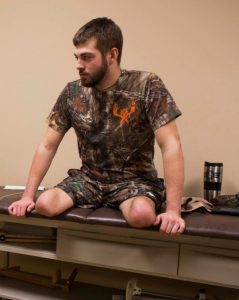 Immediately following an amputation is a very confusing and sometimes depressing situation. Coping with the initial feelings of loss can be overwhelming in the beginning. It can be a very emotional time as you begin to understand your new body as it heals from the surgery.
Immediately following an amputation is a very confusing and sometimes depressing situation. Coping with the initial feelings of loss can be overwhelming in the beginning. It can be a very emotional time as you begin to understand your new body as it heals from the surgery.
Your doctor will monitor the progress of your healing limb and will prescribe a limb shrinker sock to help control swelling. The shrinker will also provide gentle compression and protection that can be very beneficial to prepare the limb for your prosthetic fitting. Your limb will continue to heal and reduce in volume for the first year following the amputation surgery.
Initially, most amputees can experience a variety of sensations including phantom limb sensation, phantom pain and nerve pain.
Phantom limb sensation is the feeling that the part of the body that has been amputated is still there. With a leg amputation, the patient may still feel the foot and toes of the amputated limb. In most cases, it is possible to move the toes of the amputated foot in your mind. Doing exercises with the part that has been amputated is beneficial as this helps to increase blood flow to the end of the limb. It can also help to provide feedback to the brain by moving the amputated phantom limb, reducing phantom pain.
Phantom limb pain is the sensation of pain in the part of the body that has been amputated. Usually, by doing mental exercises with the phantom limb, these sensations can fade away during the first few months following an amputation.
For most people, phantom limb pain reduces significantly once you can begin massaging your limb and begin the rehabilitation process with a physical therapist.
As soon as the stitches or staples are removed, your doctor or physical therapist may have you begin working on regaining movement and desensitizing the end of the amputated limb.
Desensitizing is very important to prepare the limb for weight bearing in a prosthetic limb. Initially, the amputation site will be very sensitive to pressure but the more you work with your limb, the sensitivity will reduce. You can start by gently massaging the end of the limb and lightly tapping it until you can take more vigorous contact. Mobilizing the incision will keep the scar tissue loose so it does not adhere to the bone.
Once your limb is healing properly and has stabilized sufficiently, your doctor will write a prescription for a prosthesis that you will need to bring with you to your first appointment.
There are many different levels of amputation and each different level brings a unique protocol for preparing the limb for use with the prosthesis. There are hundreds of prosthetic component options for the various amputation levels. Our clinical team will evaluate your needs and your specific limb involvement to develop an individualized prosthetic plan that is most appropriate for you.
